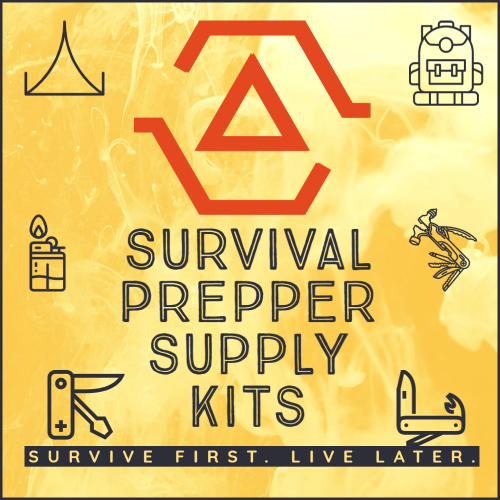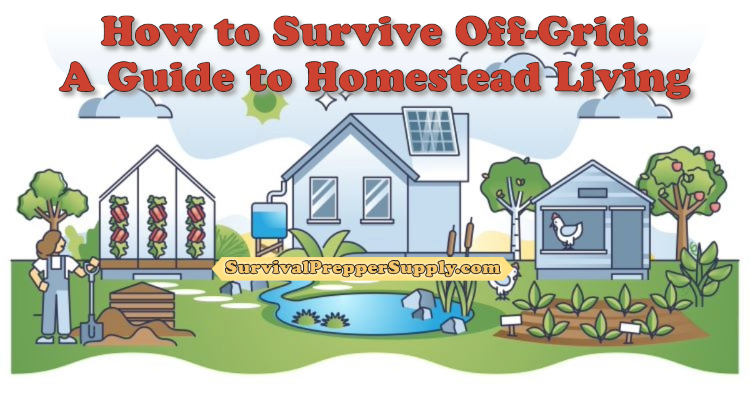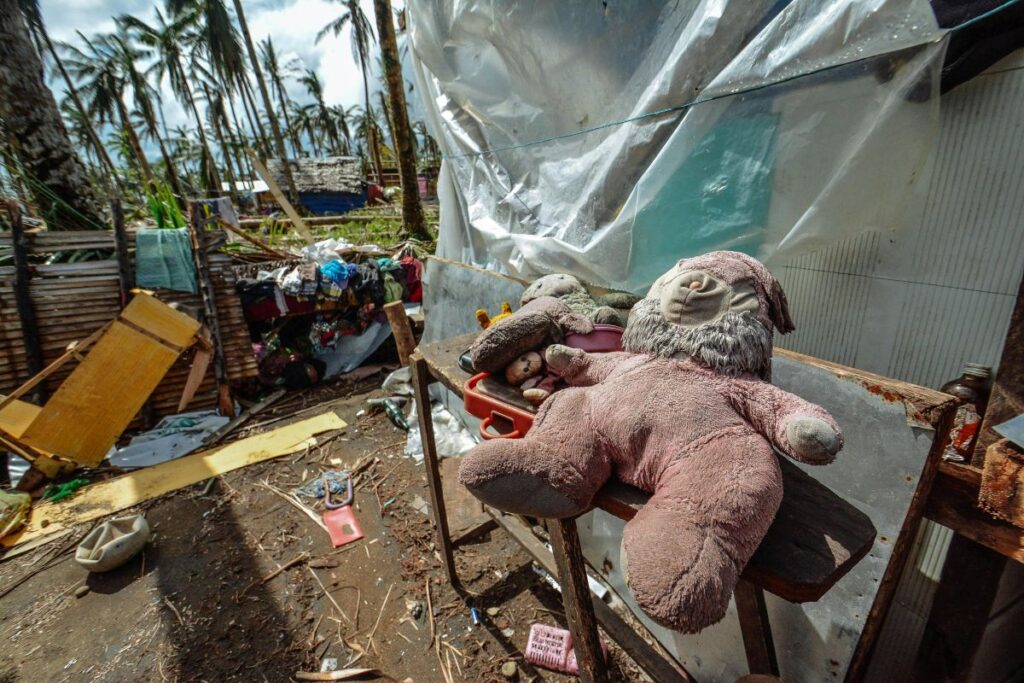For many, how to survive off-grid for homestead living is a doable and enticing option. I’ve almost always lived an off-grid survival, country lifestyle. I had horses, so living in the country was a necessity. In our world, where tech rules, cities are expanding, and life moves at breakneck speeds, going off the grid is no longer just a fantasy. This is your guide to homestead living.
The allure of a lifestyle devoid of societal stress, utility costs, and incessant electronic noise strikes a chord with those yearning for a simpler, more independent life deeply connected to the natural world. Yet, it’s also a strategic move, a safety net, preparing for a potential emergency should the power grid fail.
Living off-grid isn’t just about seeking tranquility. It’s a real-world solution to some of our biggest challenges. The instability of main power grids, lack of water, increasing energy prices, and environmental harm touch everyone’s lives.
Living off the grid paves the way for a sustainable, self-sufficient lifestyle with a smaller ecological impact. Recent worldwide happenings, like health crises, weather-induced power problems, and shaky economies, have spotlighted the weak spots in our existing structures.
Read this – April 8, 2024 Solar Eclipse Survival Tips
Living off the grid provides a robust defense against life’s unpredictability. It empowers people to steer their own course and flourish even when traditional systems stumble. Embracing this lifestyle signifies a significant departure from the usual way of life.
Living off-grid is a way of life highlighting independence, innovation, and a deep connection with nature. It’s all about growing food and tapping into renewable energy sources. This lifestyle requires a proactive attitude and a readiness to learn and adjust.
Read this – Surviving with Seniors: Harnessing the Golden Wisdom for Emergency Preparedness
Adopting this way of life isn’t a walk in the park. The shift can be quite steep, calling for fresh abilities, thorough planning, and getting used to a new rhythm of life. Locating the perfect patch of land, complying with neighborhood rules, and juggling resources can seem like a mountain for the everyday person.
The benefits are indeed considerable. Choosing an off-grid lifestyle provides unmatched liberty, a more profound bond with nature and society, and a feeling of achievement that stems from self-sufficiency.
This way of life lets you make your own rules and decisions instead of following what society expects. It’s attractive because it offers independence, a sustainable lifestyle, and a focus on what matters. But remember, it requires thought, planning, and hard work.
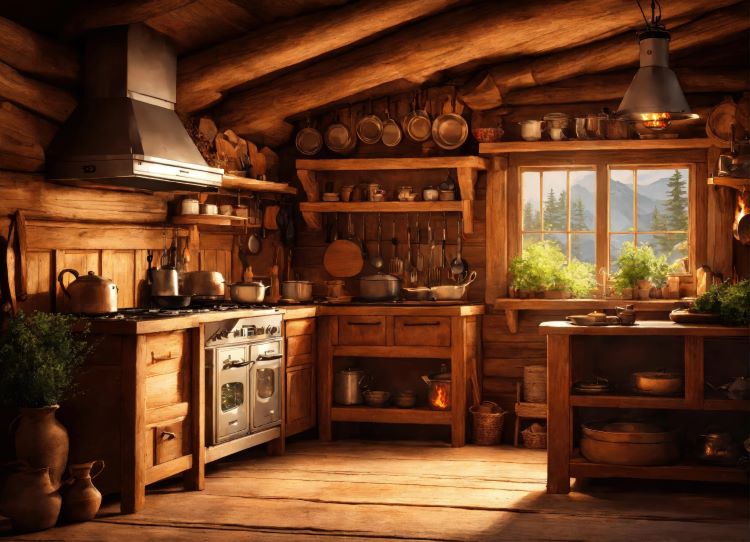
What Does Living Off the Grid Mean?
The concept of living off the grid has captured the imagination of many, yet it often remains shrouded in mystery and misconception. Living off the grid refers to a lifestyle choice that involves disconnecting from the centralized utility services of electricity, water, and sometimes even gas, and usually implies a level of self-sufficiency.
It’s about relying on renewable energy sources, managing water supply, growing food, and being responsible for waste. Examples of off-grid living vary widely, ranging from remote cabins powered by solar panels in the wilderness to eco-villages using rainwater harvesting systems.
Some choose a nomadic lifestyle in customized vans. In contrast, others build sustainable homes in suburban areas, independent of local utilities. “Living off the grid” often conjures images of isolated hermits or extreme survivalists.
However, this lifestyle can be as diverse as those pursuing it. Some common misconceptions include the belief that it’s only for anti-social types. In reality, many off-gridders are part of vibrant communities and prioritize connections with neighbors and nature.
Another misconception is that it requires sacrificing comfort, but with proper planning and technology, off-grid living can offer many of the comforts of traditional homes. Finally, there’s a misconception that it’s only for the wealthy or highly skilled.
Related – A Survival Prepper’s Buyer’s Guide to Rabbit Hutches for Homesteading
While some investment may be required, off-grid living is accessible with various budgets, and many skills can be learned for this lifestyle. Living off the grid offers numerous benefits that align with the principles of survival for various individuals and communities.
Sustainability, a critical aspect of this lifestyle, safeguards against potential energy shortages and instabilities, fortifying the homestead’s resilience. Independence is another key survival benefit, offering freedom from utility bills and control over vital resources like water and energy.
This autonomy empowers individuals to secure their needs without reliance on external systems that may fail or become compromised. By taking charge of these essential aspects, off-gridders enhance their survival capabilities and reduce vulnerabilities.
Living off the grid fosters a deeper connection to nature, a vital component of survival. Understanding and aligning with natural cycles, the environment, and the land’s inherent resources leads to more effective survival strategies.
It enhances the ability to predict weather patterns, utilize native plants, and survive in any ecosystem. This profound connection enriches life and strengthens the skills and insights necessary for survival in an ever-changing world.
However, this lifestyle also comes with its challenges. The initial costs of setting up an off-grid system can be significant, requiring careful financial planning and potentially demanding substantial investment.
Maintaining an off-grid lifestyle requires regular attention to energy systems, water sources, and other necessities. This ongoing responsibility can be time-consuming and may require new skills.
Lastly, a learning curve is often associated with acquiring new skills and adjusting to a different way of life. This can be challenging for some, requiring patience, perseverance, and a willingness to adapt and grow.
Yet, for those who embrace these challenges, the rewards of living off the grid can be profound and life-affirming. Living off the grid is a multifaceted and highly individualized lifestyle choice.
Evaluating Your Readiness for Off-Grid Living
Evaluating your readiness for off-grid living is crucial in preparing for a lifestyle centered around survival. This assessment involves a deep understanding of personal and family needs specific to off-grid living.
Considering individual health requirements, skill sets, and daily living necessities will guide you in structuring a lifestyle emphasizing resilience and self-reliance. Financial considerations are equally vital, as off-grid living may require significant investment in tools, land, and renewable energy sources.
Related – Homesteading Property Perks for Survival Preppers
Planning financially ensures that you have the means to establish and maintain a survival-focused homestead that will sustain your family in various circumstances. Perhaps one of the most overlooked aspects of readiness is the psychological and emotional preparation for the potential hardships of off-grid living.
Life away from conventional comforts and conveniences can bring unexpected challenges that test one’s resolve and adaptability. Understanding and preparing for these mental and emotional hardships will strengthen your ability to thrive in an off-grid environment, reinforcing your capacity for survival when facing the unforeseen trials that may arise in this unique and rewarding way of life.
Choosing the Right Off-Grid Location
Choosing the right off-grid location is vital in ensuring the success and sustainability of your survival-focused lifestyle. Climate considerations must be thoroughly examined, as the weather patterns, seasonal variations, and temperature extremes will directly impact your ability to grow food, harvest water, and maintain energy systems.
The land’s features and resources are equally critical, with factors such as soil quality, water accessibility, and natural shelter influencing your capacity to build a self-sufficient homestead.
Read this – How to Build a Fuel-Efficient Rocket Stove and Cook Your Food on It
Selecting land with the right resources can differentiate between thriving and surviving in an off-grid setting. Understanding and complying with local laws and regulations specific to off-grid living is also essential.
Regulations regarding rainwater harvesting, waste disposal, and building codes may differ greatly by region, and adherence to these legal requirements will ensure that your off-grid lifestyle aligns with local governance.
Navigating these complex considerations requires careful planning and research, but the effort invested in selecting the right location lays the groundwork for a successful and enduring off-grid survival experience.
Please note that this post contains affiliate links, meaning I will get a small commission for qualifying purchases at no extra cost to the buyer.
Designing Your Homestead
Creating a homestead prepared for off-grid living requires a holistic approach that integrates essential elements such as shelter, energy systems, and water collection. Each component must be carefully planned and tailored to suit the unique demands of a survival-focused lifestyle.
2nd Edition
"Gaia's Garden will be recorded in history as a milestone for gardeners and landscapers. . . An amazing achievement."--Paul Stamets
The classic book about ecological gardening--whatever size your garden--with over 250,000 copies sold!
"A great book!"--Men's Journal
Gaia’s Garden has sparked the imagination of home gardeners worldwide by introducing a simple message: working with nature, not against her, results in more beautiful, abundant, and forgiving gardens.
It’s fun and easy--even for the beginner--to create a “backyard ecosystem” by assembling communities of plants that can work cooperatively and perform a variety of functions, including:
- Building and maintaining soil fertility and structure
- Catching and conserving water in the landscape
- Providing a rewilded and biodiverse habitat for beneficial insects, birds, and animals
- Growing an edible “forest” that yields seasonal fruits, nuts, and other foods
The design of shelter and housing is a foundational aspect of off-grid living. Consideration must be given to both short-term survival and long-term comfort. Materials chosen should provide insulation, durability, and protection against extreme weather conditions.
Layout and orientation should utilize natural light and passive heating or cooling. Including storage for supplies, a space for growing food, and areas for livestock (if applicable) can enhance the homestead’s self-sufficiency.
Flexibility in design to accommodate changes and expansions is also wise, allowing the shelter to evolve with your needs and knowledge. A robust and reliable energy system is paramount for off-grid survival, too.
Solar panels harnessing the sun’s energy can provide a sustainable power source, but their efficiency must be weighed against the region’s sunlight availability. Wind turbines offer an alternative or complementary option, especially in areas with consistent wind patterns.
Generators powered by gasoline or propane can serve as temporary or backup power sources during low renewable energy production periods. Integrating these systems, proper battery storage, and energy conservation measures create a resilient energy network supporting the homestead’s essential functions, from cooking to communication.
Water is vital for survival, and an off-grid homestead must have a reliable system for collecting and purifying this essential resource. Rainwater harvesting systems can be installed to capture and store water, but local regulations and climate factors must be considered.
Access to a natural water source, such as a spring or stream, can be invaluable. Still, purification methods must be in place to ensure safety. Filtration systems, boiling practices, or chemical treatment options can purify water for drinking, cooking, and hygiene.
Additionally, greywater recycling systems can be implemented to conserve water for non-potable uses, such as irrigation. By thoughtfully integrating these elements, you can create a homestead that supports survival events.
Budgeting and Financing for Off-Grid Living
Embarking on an off-grid lifestyle requires meticulous financial planning and budgeting, especially when survival is a core focus. The financial aspects encompass various facets, from initial investments to ongoing expenses, and each must be managed to sustain a resilient and self-reliant way of life.
Accurate estimation of costs is vital in preparing for off-grid living. These costs include:
- land purchase,
- construction or renovation of shelter,
- installation of energy systems,
- water collection infrastructure,
- and potential agricultural investments like seeds and livestock.
Ongoing maintenance costs, property taxes, insurance, and other recurring expenses should also be accounted for. Careful research, consultation with experts, and examination of existing off-grid setups can help generate a realistic budget that aligns with survival needs and lifestyle goals.
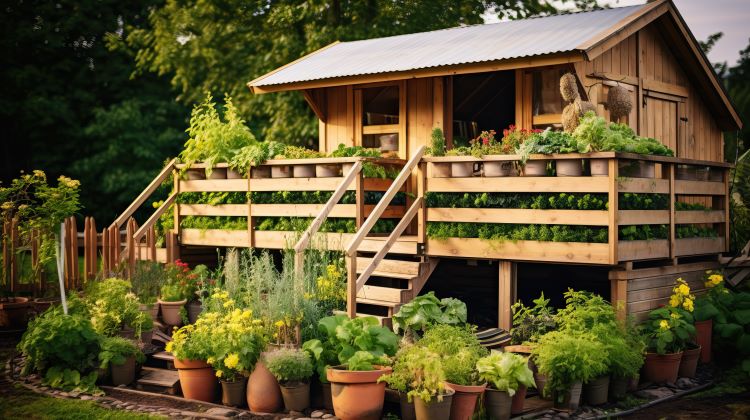
Funding the transition to off-grid living might require exploring various financing options. Traditional savings may be a starting point, but other avenues, such as personal loans, grants targeting renewable energy or sustainable farming, or even crowdfunding campaigns, might be viable options.
Partnerships or cooperative living arrangements can also be a way to share costs and resources. Investigating these possibilities with a clear understanding of terms, interest rates, and potential risks is essential to ensure they align with your long-term survival strategy.
While off-grid living may require significant investment, numerous ways exist to save money without compromising essential survival components. Utilizing reclaimed or recycled building materials, buying used equipment, or learning to DIY essential systems can reduce costs.
Engaging in barter or trade within local off-grid or farming communities can also provide access to valuable resources or services. Careful planning to maximize energy efficiency, water conservation, and waste reduction can lead to ongoing savings and enhance the homestead’s sustainability.
Investing wisely and managing resources with foresight lays the groundwork for a life that thrives independently and resonates with the core values of survival, independence, and resilience.
Farming and Gardening for Off-Grid Living
Embarking on farming and gardening in an off-grid setting requires understanding the intricate relationship between the land, weather, plants, and animals. This alignment with nature is fulfilling and essential for survival, as it becomes the core source of food and possibly income.
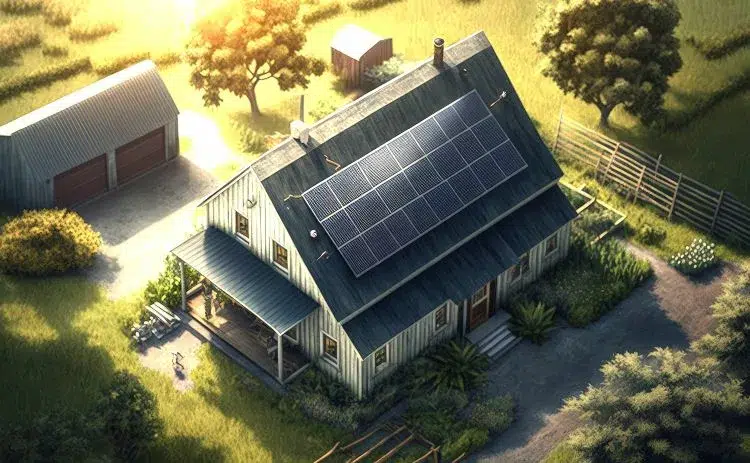
Soil preparation is the cornerstone of thriving farming and gardening. Testing the soil for pH levels, nutrients, and texture helps understand what crops will thrive and what amendments may be necessary.
Incorporating organic matter, composting, and practicing crop rotation can improve soil health and productivity. Selecting the right crops based on climate, sunlight, and water availability and timing the planting appropriately can make the difference between abundance and scarcity.
For survival, it’s wise to focus on nutrient-dense and calorie-rich crops that store well, like potatoes, grains, and legumes. Perennial plants can also provide ongoing food sources with less annual labor.
Read this – Selecting the Right Grain Mill for Emergencies and Everyday Use
Animal husbandry offers valuable contributions to survival if incorporated into the off-grid lifestyle. Chickens, goats, rabbits, or larger livestock can provide meat, milk, eggs, and other products.
The care responsibilities include appropriate shelter, feeding, breeding, health management, and understanding the ethical considerations of raising animals for food. These animals also contribute to the farm’s ecosystem with manure for fertilizing, pest control, and other symbiotic relationships that enhance productivity.
Aligning farming and gardening practices with the natural cycles and seasons is fundamental for off-grid living. The local climate and weather patterns guide understanding when to plant, tend, harvest, and rest the land.
Seasonal considerations also dictate tasks like preserving the harvest, preparing for winter, animal breeding cycles, and managing water resources. Creating a seasonal calendar specific to your location helps plan activities, order supplies, and ensure a continuous food supply.
Farming and gardening for off-grid living are both an art and a science, intertwining practical skills with a passion for survival prepping. The rewards of this labor extend beyond mere sustenance, nurturing a lifestyle that resonates with nature’s rhythms and enhances the homestead’s survival capabilities.
Food Preservation and Cooking Off the Grid
Living off the grid, particularly in a survival context, requires a strategic food preservation and cooking approach. Ensuring a stable food supply and the ability to prepare nutritious meals without conventional utilities involves both traditional skills and innovative techniques.
[10 Books in 1]: The Complete Expert’s Guide To Harvest, Store, Germinate, Keep Your Vegetable And Herb Seeds Fresh For Years & Build Your Seed Bank Like A Pro. Preppers Approved.
Unlock the secrets of seed saving and create a thriving, self-sustaining garden with this ultimate guide!
Are you an aspiring gardener or a seasoned green thumb looking to enhance your plant's genetic diversity, save money, and promote sustainability?
Canning is a time-honored method for preserving fruits, vegetables, meats, and more. It requires understanding safety protocols to prevent spoilage and contamination. It involves processing food in airtight containers and can be done through water bath canning or pressure canning.
Water bath canning is suitable for high-acid foods like jams and pickles, while pressure canning is needed for low-acid foods like meats and vegetables. If off-grid energy solutions support a freezer, freezing effectively preserves various foods, from produce to prepared meals. Proper packaging, labeling, and managing freezer space and energy consumption are critical factors in utilizing this preservation method.
Related – Survival Prepping 101 Series Part 3: Start Storing the Appropriate Types of Food
Dehydration offers a low-tech and energy-efficient option for preserving foods. By removing moisture, foods like fruits, vegetables, herbs, and even meats can be stored long-term without refrigeration. Depending on available resources and climate conditions, dehydration can be accomplished through solar designs or air drying.
Off-grid cooking involves creativity and flexibility, relying on energy sources and equipment that align with the homestead’s capabilities. Depending on availability and weather conditions, wood-fired stoves, solar ovens, rocket stoves, or outdoor cooking on an open fire might all be utilized.
These methods often require recipe adjustments, cooking times, and techniques. Planning meals around available fuel, seasonal ingredients, and energy efficiency is essential for off-grid culinary success.
Nutritional planning for off-grid living is vital for survival and well-being. Designing a diet that meets all essential nutritional requirements means clearly understanding what can be grown, raised, foraged, or traded locally.
Balancing the intake of carbohydrates, proteins, fats, vitamins, and minerals involves thoughtful meal planning, cultivating diverse crops, possible supplementation, and creative cooking techniques.
Related – The Ultimate SHTF Survival Lessons Guide, Lesson #1-2, Food and Water
Nutritional planning is essential to survival, demanding attention to detail and strategic thinking. Every meal is critical to sustaining life and maintaining physical strength in an off-grid setting. With limited resources and the constant need to adapt to changing conditions, proper planning ensures that all dietary needs are met, avoiding deficiencies that could impair health and performance.
This pragmatic approach to nutrition underscores the reality of living off the grid, where every decision impacts survival, resilience, and the ability to thrive independently in challenging circumstances.
DIY and Home Maintenance Off the Grid
Surviving off the grid requires a broad set of skills and the ability to perform a wide range of tasks that might otherwise be outsourced in a conventional living situation. From constructing shelters to fixing everyday wear and tear, DIY and home maintenance become vital survival skills.
Being self-reliant off the grid requires mastering basic carpentry, plumbing, and other hands-on skills without relying on electricity. Constructing and repairing structures, creating functional water systems, and handling other fundamental tasks are essential to keeping a homestead functional and safe.
Knowing how to build and repair wooden structures is a key survival skill. Whether framing a shelter, repairing a broken door, or creating simple furniture, understanding joints, measurements, and using hand tools becomes indispensable.
An efficient water system is crucial for survival. Skills like installing manual pumps, fixing leaks, and understanding gravity-fed systems can make the difference between a comfortable living situation and a constant struggle.
Masonry, metalworking, and mechanical repair might also be involved. The ability to work with various materials, often improvising with what’s available, adds to the adaptability needed for off-grid living.
Choosing and maintaining the right tools is as important as knowing how to use them. A well-chosen set of hand tools, including saws, hammers, screwdrivers, pliers, and wrenches, can accomplish most tasks without needing electric power.
Regular maintenance, such as sharpening, oiling, and proper storage, extends their lifespan and ensures they’re ready when needed. Living off the grid, one quickly becomes a jack-of-all-trades, handling a variety of repairs, from patching roofs to fixing a wind turbine.
An essential survival skill is developing a problem-solving mindset and the ability to diagnose and fix issues with limited resources. It involves creativity, patience, and a willingness to learn from mistakes.
Whether it’s a broken water pipe or a malfunctioning solar panel, the ability to troubleshoot and fix problems on the spot becomes a daily part of life. DIY and home maintenance skills are not just about convenience or cost-saving in an off-grid environment; they are fundamental to survival.
The ability to build, repair, and innovate with limited resources creates a sense of empowerment and independence beyond mere living. It shapes the essence of off-grid survival, where reliance on oneself isn’t just a choice but a necessity and where every skill learned adds to the resilience and sustainability of the homestead.
Health and Wellness Off-Grid
In a survival-oriented, off-grid environment, caring for one’s health goes beyond mere comfort or well-being; it’s a matter of life and death. The absence of immediate medical facilities or conventional healthcare requires a comprehensive approach to maintaining health and handling medical situations as they arise.
First aid skills and a well-stocked kit are paramount in an off-grid setting. Knowing how to handle wounds, burns, fractures, and other common injuries can make a difference in a crisis.
Managing chronic health conditions off the grid requires careful planning. It is critical to stockpile necessary medications, understand their proper storage, and have a contingency plan for when supplies run low.
Having a plan for medical emergencies that may require professional intervention, such as a way to communicate with or reach the nearest medical facility, is an essential part of preparedness.
Regular exercise is vital to maintain strength, stamina, and overall health. Whether through manual labor or dedicated fitness routines, keeping the body in good shape is essential for survival.
Survival off the grid isn’t just about physical health but also maintaining mental strength and resilience. Living off the grid can be isolating and stressful. Engaging in activities that promote mental well-being, such as meditation, hobbies, or connecting with others, is crucial to keeping a balanced and positive outlook.
When traditional medications are not readily available, natural remedies become an important aspect of health care. Knowledge of local plants and their medicinal properties can provide natural solutions for common ailments like colds, digestive issues, or skin problems.
Practices like acupuncture, massage, or other alternative healing methods can relieve various physical and emotional concerns. Using natural remedies as part of a regular health routine can support the immune system and help prevent illness.
Proper nutrition, hygiene, and awareness of potential environmental health risks are essential here. Health and wellness off the grid require a multifaceted approach that combines traditional medical understanding with alternative practices and a strong focus on prevention.
It’s about being proactive, self-reliant, and adaptable in a setting where professional medical help may not be immediately accessible. The stakes are high, and the margin for error is slim, making health and wellness a central pillar of survival in an off-grid lifestyle.
Integrating knowledge, planning, and daily practices creates a resilient defense against health challenges and ensures that physical and mental well-being are maintained in the most demanding circumstances.
Community and Social Interaction
Survival in an off-grid setting isn’t just about physical sustenance and shelter; human connection and community are equally vital. The dynamics of community and social interaction in an off-grid environment differ significantly from conventional living, requiring a unique approach to building connections, communicating, and balancing the human need for solitude and social engagement.
In an off-grid lifestyle, it can be vital to seek out neighbors or nearby communities with similar values and lifestyle choices. These connections foster mutual support, the exchange of resources, and shared knowledge.
If available, integration into a local community requires understanding and respecting local customs, participating in community events, and contributing to communal projects.
Building a network of friends, neighbors, and fellow off-gridders creates a safety net. In times of need, these connections can provide help through labor, supplies, or emotional support.
Off-grid living often means reduced access to conventional communication technologies like cell phones or the Internet. Alternative communication strategies become essential. Handheld or CB radios may serve as vital tools for communicating with neighbors or in emergencies.
Leaving notes or establishing regular meeting times and places can facilitate communication without modern technology. Though less convenient, face-to-face visits foster strong connections and trust within the community.
Living off the grid often means embracing significant solitude, especially in a remote location. Balancing the need for solitude with social interaction requires conscious effort.
Recognizing individual needs for social interaction or solitude helps create a satisfying lifestyle. Some may thrive on solitude, while others may need regular social engagement.
Planning regular visits, community gatherings, or involvement in local groups can ensure that social needs are met. Solitude can be a powerful tool for reflection, growth, and self-reliance.
Embracing it as part of the off-grid lifestyle can lead to a profound sense of contentment and resilience. Community and social interaction in an off-grid environment are about more than just companionship—they’re a critical component of survival.
Security and Safety Off the Grid
Living off the grid requires a unique approach to security and safety, protecting property and possessions, and preparing for emergencies. In an isolated environment, ensuring the physical security of your property becomes paramount.
This can involve implementing fences, locks, gates, or even guard animals like dogs. The right combination of these elements depends on the location’s risks and challenges.
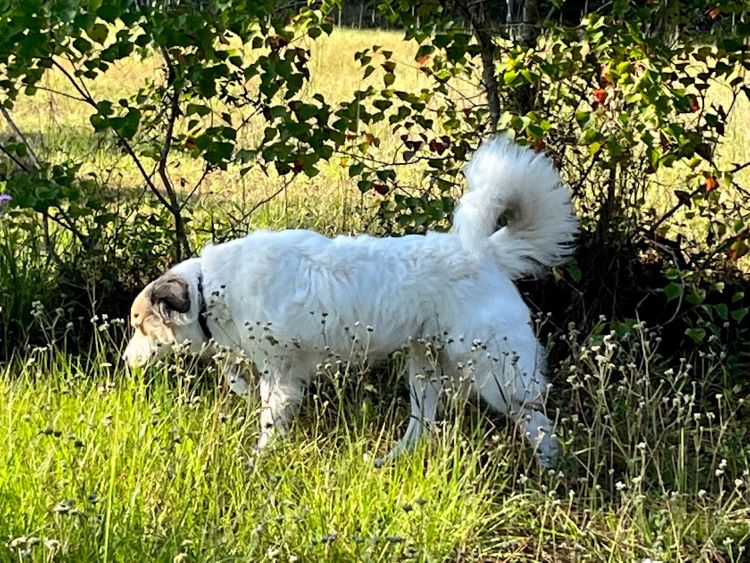
Understanding the local risks, such as potential wildlife threats or human intruders, and remaining vigilant is crucial. Regular patrols, being aware of surroundings, and knowing who belongs in the area and who doesn’t can help in the early detection of any threats.
Sometimes, working with neighboring off-gridders or local communities to establish shared security protocols and watch systems can be highly effective. Keeping a well-maintained inventory of possessions, especially valuable or essential items, helps track and safeguard them.
Employing hidden storage, secure containers, or even decoy setups can enhance protection. The first step in effective planning is to understand the unique emergencies that may arise in your specific location, whether natural disasters like storms or floods or human-made problems such as accidents or health emergencies.
This includes establishing clear protocols for different scenarios, identifying escape routes, creating emergency contact lists, and determining rendezvous points for family or community members.
Related – A Survival Water Storage Guide to Using Rainwater for Simple Living
An emergency stockpile of food, water, medical supplies, and other essentials ensures that you and your family can sustain themselves and each other during a crisis. It is crucial to review and update these supplies regularly.
Regular drills and training in emergency procedures, alone and with any family or community members, ensure that everyone knows what to do and can act efficiently when an emergency strikes.
Part of emergency planning is reacting to crises and building a resilient lifestyle. This may include constructing buildings that withstand extreme weather, diversifying food and water sources, or creating redundant energy systems.
In an off-grid lifestyle, where reliance on conventional emergency services might not be an option, the importance of security and safety cannot be overstated. It requires a proactive and thorough approach.
The peace of mind that comes from knowing you have done everything possible to protect your family, possessions, and way of life is a comfort and a vital aspect of survival and success in living off the grid.
Living off the grid is a path with unique challenges and rewards, encompassing everything from shelter and energy to social interaction and safety. The journey towards off-grid living is a transformative one.
It takes courage to step out of conventional society’s comforts and embrace a life that demands continuous learning, adaptability, a deep connection with the environment, and opportunities for survival.
But as daunting as this path may seem, it’s a journey within reach for those willing to take the plunge. The journey will be uniquely your own, filled with personal discoveries, growth, and fulfillment.
Let the information and insights shared here be your starting point, a spark that ignites your passion for a life less ordinary. Let it inspire you to take those next steps, whether simply reducing your dependence on the grid or fully embracing a homestead’s self-reliant life.
Your journey begins now if you’re ready to start. Take the next step with faith and determination and become part of a growing movement of individuals seeking peace of mind and self-reliance. Do you live off-grid? Do you want to? Where do you want to live off-grid? Leave comments below to help others decide what to do, too!
